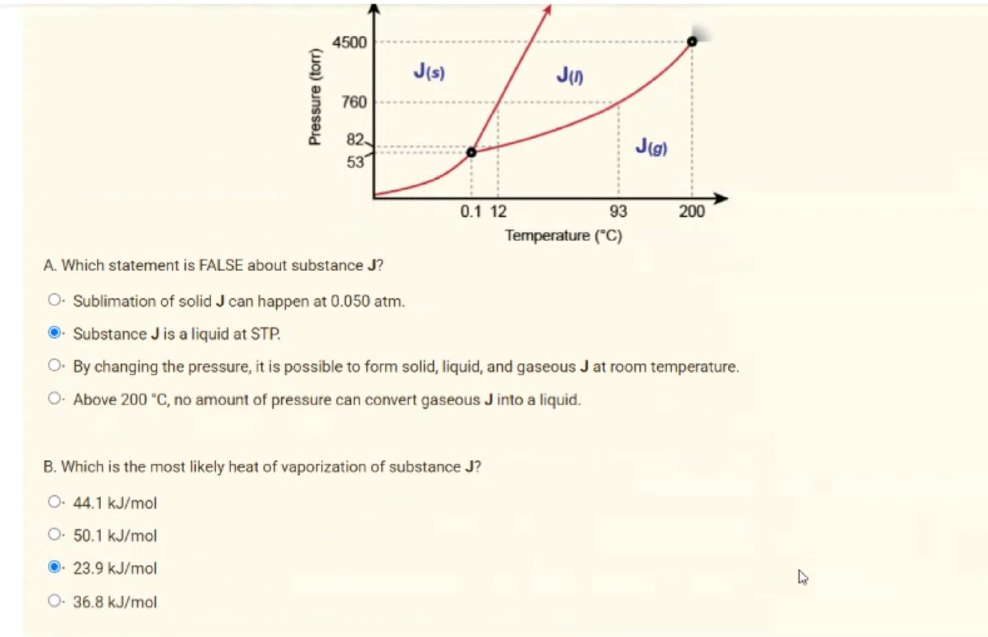A. Which statement is FALSE about substance J? O. Sublimation of solid J can happen at 0.050 atm. Substance J is a liquid at STP. O. By changing the pressure, it is possible to form solid, liquid, and gaseous J at room temperature. O- Above 200 °C, no amount of pressure can convert gaseous J into a liquid. B. Which is the most likely heat of vaporization of substance J? O- 44.1 kJ/mol O- 50.1 kJ/mol 23.9 kJ/mol O- 36.8 kJ/mol 2
A. Which statement is FALSE about substance J? O. Sublimation of solid J can happen at 0.050 atm. Substance J is a liquid at STP. O. By changing the pressure, it is possible to form solid, liquid, and gaseous J at room temperature. O- Above 200 °C, no amount of pressure can convert gaseous J into a liquid. B. Which is the most likely heat of vaporization of substance J? O- 44.1 kJ/mol O- 50.1 kJ/mol 23.9 kJ/mol O- 36.8 kJ/mol 2
General Chemistry - Standalone book (MindTap Course List)
11th Edition
ISBN:9781305580343
Author:Steven D. Gammon, Ebbing, Darrell Ebbing, Steven D., Darrell; Gammon, Darrell Ebbing; Steven D. Gammon, Darrell D.; Gammon, Ebbing; Steven D. Gammon; Darrell
Publisher:Steven D. Gammon, Ebbing, Darrell Ebbing, Steven D., Darrell; Gammon, Darrell Ebbing; Steven D. Gammon, Darrell D.; Gammon, Ebbing; Steven D. Gammon; Darrell
Chapter11: States Of Matter; Liquids And Solids
Section: Chapter Questions
Problem 11.57QP: Which of the following substances can be liquefied by applying pressure at 25C? For those that...
Related questions
Question
is this correct?

Transcribed Image Text:4500
760
82
53
93
200
Temperature (°C)
A. Which statement is FALSE about substance J?
O. Sublimation of solid J can happen at 0.050 atm.
Substance J is a liquid at STP.
O. By changing the pressure, it is possible to form solid, liquid, and gaseous J at room temperature.
O- Above 200 °C, no amount of pressure can convert gaseous J into a liquid.
B. Which is the most likely heat of vaporization of substance J?
O. 44.1 kJ/mol
O. 50.1 kJ/mol
23.9 kJ/mol
O- 36.8 kJ/mol
Pressure (torr)
J(s)
0.1 12
J(1)
J(g)
4
Expert Solution
This question has been solved!
Explore an expertly crafted, step-by-step solution for a thorough understanding of key concepts.
Step by step
Solved in 5 steps with 4 images

Knowledge Booster
Learn more about
Need a deep-dive on the concept behind this application? Look no further. Learn more about this topic, chemistry and related others by exploring similar questions and additional content below.Recommended textbooks for you

General Chemistry - Standalone book (MindTap Cour…
Chemistry
ISBN:
9781305580343
Author:
Steven D. Gammon, Ebbing, Darrell Ebbing, Steven D., Darrell; Gammon, Darrell Ebbing; Steven D. Gammon, Darrell D.; Gammon, Ebbing; Steven D. Gammon; Darrell
Publisher:
Cengage Learning

Chemistry for Engineering Students
Chemistry
ISBN:
9781337398909
Author:
Lawrence S. Brown, Tom Holme
Publisher:
Cengage Learning

Principles of Modern Chemistry
Chemistry
ISBN:
9781305079113
Author:
David W. Oxtoby, H. Pat Gillis, Laurie J. Butler
Publisher:
Cengage Learning

General Chemistry - Standalone book (MindTap Cour…
Chemistry
ISBN:
9781305580343
Author:
Steven D. Gammon, Ebbing, Darrell Ebbing, Steven D., Darrell; Gammon, Darrell Ebbing; Steven D. Gammon, Darrell D.; Gammon, Ebbing; Steven D. Gammon; Darrell
Publisher:
Cengage Learning

Chemistry for Engineering Students
Chemistry
ISBN:
9781337398909
Author:
Lawrence S. Brown, Tom Holme
Publisher:
Cengage Learning

Principles of Modern Chemistry
Chemistry
ISBN:
9781305079113
Author:
David W. Oxtoby, H. Pat Gillis, Laurie J. Butler
Publisher:
Cengage Learning

Chemistry
Chemistry
ISBN:
9781305957404
Author:
Steven S. Zumdahl, Susan A. Zumdahl, Donald J. DeCoste
Publisher:
Cengage Learning


Chemistry: An Atoms First Approach
Chemistry
ISBN:
9781305079243
Author:
Steven S. Zumdahl, Susan A. Zumdahl
Publisher:
Cengage Learning